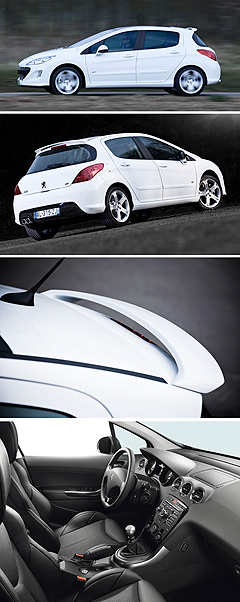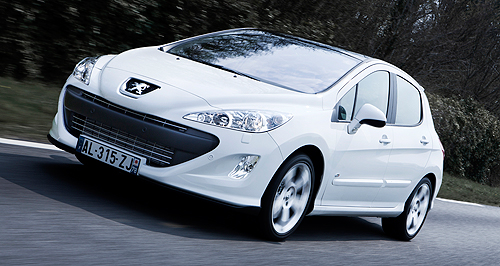Future models - Peugeot - 308 - GTiPug hot hatch blasts backIt's baaack: Peugeot has revived the GTi badge in its 308 range. Peugeot at last plumbs its performance heritage with the debut of a 308 GTi24 May 2010 PEUGEOT is back on the hot-hatch warpath with the newly announced 308 GTi, a decade after the demise of its 306 GTi-6 predecessor. With its crosshairs set squarely on the wildly successful Volkswagen Golf GTI, the lower-case ‘i’ French GTi is slated for an Australian release next year at the earliest as the flagship model in the 15-month old small car range. “We’re still in discussions about price so we’re not confirming if or when the 308 GTi will come to Australia,” said Peugeot Automobiles Australia sales and marketing manager Richard Grant. “We would really love to have it, and it is definitely on our radar.” On sale from June 10 in France, and available only as a five-door hatch, the 308 GTi is powered by a Euro V emissions-compliant, English-built, twin-scroll turbocharged, direct-injection variable-valve-timing four-cylinder petrol engine of BMW design (a related version lives in the Mini Cooper S and derivatives), driving the front wheels via a six-speed manual gearbox. No auto is available for the time being.  Transplanted directly from the 308-based RCZ coupe due in Australia soon, the 1598cc 1.6-litre unit develops a 2005-2009 Mk5 Golf GTI-equalling 147kW of power (from 5500 to 6800rpm) and 275Nm of torque (old GTI: 280Nm) between 1700 and 4500rpm. Transplanted directly from the 308-based RCZ coupe due in Australia soon, the 1598cc 1.6-litre unit develops a 2005-2009 Mk5 Golf GTI-equalling 147kW of power (from 5500 to 6800rpm) and 275Nm of torque (old GTI: 280Nm) between 1700 and 4500rpm.By contrast, today’s 238km/h Golf VI GTI’s 2.0-litre powerplant pumps out 155kW from 5300 to 6200rpm and 280Nm between 1700 and 5200rpm. Combined with a lower kerb weight, the German hatch dispatches the 0-100km/h sprint-time some 0.8 seconds ahead of the 308 GTi’s 7.7s result. But the French car strikes back with significantly lower carbon dioxide emissions (159 grams per kilometre against the manual Golf’s 180) and better fuel consumption (6.9 litres per 100km versus 7.7 for the VW equivalent) – a corollary of its variable lift of the intake valves coupled with variable timing of both the intake and exhaust camshafts. Speaking of the latter, Peugeot says the exhaust has been tuned accordingly thanks to the implementation of the company’s ‘Sound System’ vibrating membrane technology. Underneath, the GTi improves on the regular 308’s MacPherson strut front and torsion beam rear suspension architecture with the adoption of larger diameter bearings from the 407, unique damper settings (with the front springs and shockers employing 2mm thicker damper rods), and a 10mm ride height reduction for an improved centre of gravity. No changes have been made to the speed-sensitive electro-hydraulic powered steering system. Larger brakes are fitted compared with regular 308s, with 340mm vented discs up front and 290mm in the back, stopping alloy wheels shod with 225/40 R18 performance tyres. Aiding braking is a gaggle of drivability enablers (traction control, ESC, electronic brake-force distribution, and emergency brake assist) that can be disconnected. “The end result is a well balanced front-wheel drive set-up ensuring optimal accuracy and efficiency and maximum driving enjoyment and safety at all times,” Peugeot says. Whether the firm’s stylists have gone far enough to differentiate the GTi’s looks from its more mundane 308 brethren remains to be seen. Look for a black faux carbonfibre front bumper insert set in the lower ‘Sport’ front fascia from the 308 CC coupe convertible, a ‘Perla Nera’ rear diffuser, rooftop-mounted rear spoiler, chromed twin exhausts and GTi badging. An aluminium gear knob and left footrest, a leather-clad ‘sports’ steering wheel with aluminium inserts and thumb rests and a piano-black console trim heighten the sense of occasion inside. Peugeot was renowned for its hot hatch form from the moment the 205 GTi was unleashed upon an unsuspecting Europe in 1984, unsettling the Mk2 Golf GTI and catapulting the hitherto conservative brand into a fresh driver-orientated marketing realm that went on to spawn larger classics such as the 309 GTI (1986), 405 Mi-16 (1988), 306 S16 (1993) and aforementioned 306 GTi-6 (1996). The latter proved to be the final C-segment small-car Peugeot sporty until the new 308 GTi, since conflicting demands for crash-safety and vehicle refinement, along with a refocusing away from affordable performance models, led to the substantially heavier and less agile 206 GTi of 1999. This proved to be a disappointment for fans of the older series hot hatches. The 207 GTi, released in 2007, is now on special order only for Australia, and it too has languished in the eyes of driving enthusiasts against more thoroughly honed rivals like the Renaultsport Clio RS and the gone but not forgotten Ford Fiesta ST/XR4.  Read more13th of April 2010  Peugeot to race RCZSlinky new Peugeot RCZ to take on a plethora of new production cars at Nurburgring8th of March 2010  Peugeot debuts 3008 Down UnderSecond Peugeot crossover makes Australian debut two months ahead of salesAll future models Alfa Romeo Alfa Romeo Abarth Abarth Audi Audi Aston Martin Aston Martin BMW BMW Bentley Bentley Chrysler Chrysler Chevrolet Chevrolet Dodge Dodge Citroen Citroen Ferrari Ferrari DS DS Ford Ford Fiat Fiat FPV FPV Foton Foton Haval Haval Great Wall Great Wall Honda Honda Holden Holden Hyundai Hyundai HSV HSV Isuzu Isuzu Infiniti Infiniti Jeep Jeep Jaguar Jaguar Lamborghini Lamborghini Kia Kia Lexus Lexus Land Rover Land Rover Mazda Mazda Maserati Maserati Mercedes-Benz Mercedes-Benz McLaren McLaren Mini Mini Nissan Nissan Mitsubishi Mitsubishi Peugeot Peugeot Opel Opel Proton Proton Porsche Porsche Renault Renault Ram Ram Saab Saab Rolls-Royce Rolls-Royce Smart Smart Skoda Skoda Subaru Subaru SsangYong SsangYong Tesla Tesla Suzuki Suzuki Toyota Toyota Volvo Volvo308 pricing
Motor industry news |
Click to sharePeugeot modelsResearch Peugeot All future models Alfa Romeo Alfa Romeo Abarth Abarth Audi Audi Aston Martin Aston Martin BMW BMW Bentley Bentley Chrysler Chrysler Chevrolet Chevrolet Dodge Dodge Citroen Citroen Ferrari Ferrari DS DS Ford Ford Fiat Fiat FPV FPV Foton Foton Haval Haval Great Wall Great Wall Honda Honda Holden Holden Hyundai Hyundai HSV HSV Isuzu Isuzu Infiniti Infiniti Jeep Jeep Jaguar Jaguar Lamborghini Lamborghini Kia Kia Lexus Lexus Land Rover Land Rover Mazda Mazda Maserati Maserati Mercedes-Benz Mercedes-Benz McLaren McLaren Mini Mini Nissan Nissan Mitsubishi Mitsubishi Peugeot Peugeot Opel Opel Proton Proton Porsche Porsche Renault Renault Ram Ram Saab Saab Rolls-Royce Rolls-Royce Smart Smart Skoda Skoda Subaru Subaru SsangYong SsangYong Tesla Tesla Suzuki Suzuki Toyota Toyota Volvo Volvo308 pricing
Motor industry news |
















Facebook Twitter Instagram